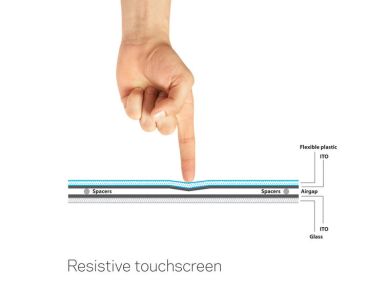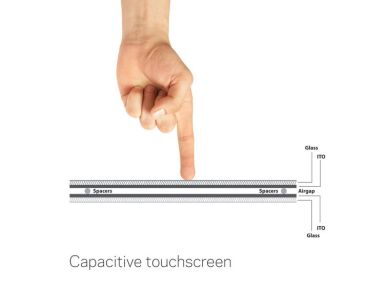This article will help you in understanding the basic differences between Resistive & Capacitive touchscreen.
Resistive Touchscreen
A resistive touchscreen comprises of several layers, out of which the flexible plastic and glass layers are two important electrically resistive layers. The front surface of resistive touchscreen panel is a scratch-resistant plastic with coating of a conductive material (mostly Indium Tin Oxide, ITO), printed underside.
The second important layer is either made of glass or hard plastic and is also coated with ITO.
Both the layers face each other and are separated with a thin gap in between. An electrical resistance is created between both the layers in such a way that charge runs from top to bottom in one layer and side-to-side in another.
When a finger or stylus tip presses down on the outer surface, both the ITO films meet. It is the measure of the resistance of both the layers at point of contact, which leads to get an accurate measurement of the touch position. The accuracy also relies on the evenness of the coating of ITO on both the layers.
Advantages of Resistive Touchscreen
- Low production cost
- High resistance to dust and water
- Best used with a finger, gloved hand or stylus
- Best suited for handwriting recognition
Disadvantages of Resistive Touchscreen
- Not too sensitive, you have to press down harder
- Poor contrast because of having additional reflections from extra layer of material placed over the screen
- Does not support multi-touch
Phones with Resisitive Touchscreen
Spice Mi-270, Nokia C2-02, Samsung Star Duos, Spice FLO, LG P520, Nokia C5-05, LG Cookie Joy, Samsung Champ Duos, Nokia C2-02
Capacitive touchscreen
A capacitive touchscreen also consists of two spaced layers of glass, which are coated with conductor such as Indium Tin Oxide (ITO). Human body is an electrical charge conductor. When a finger touches the glass of the capacitive surface, it changes the local electrostatic field. The system continuously monitors the movement of each tiny capacitor to find out the exact area where the finger had touched the screen.
Advantages of Capacitive Touchscreen
- Because capacitive touchscreen has glass layer instead of plastic, it looks brighter and sharper
- Highly touch sensititive and doesn’t need a stylus
- Supports multi-touch
Disadvantages of Capacitive Touchscreen
- Because the technology is dependent on the conductive nature of human body, it doesn’t work if the user is wearing gloves
- Because of having a complex structure, these are quite expensive
- Glass is more prone to breaking


